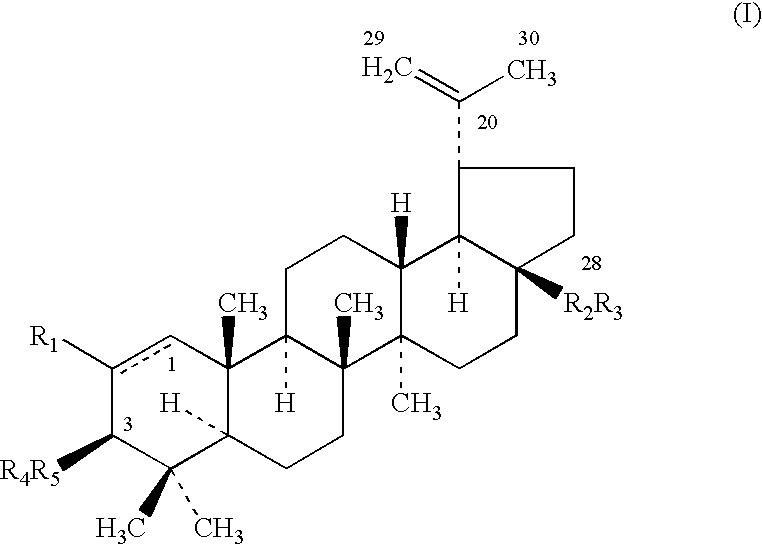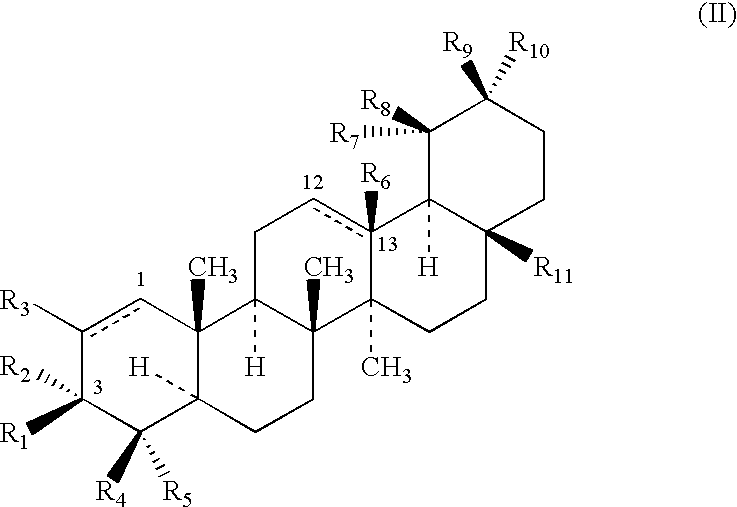Triterpenes having human antifungal and antiyeast activity
a technology of triterpenes and antifungal cells, applied in the field of therapeutic methods, can solve the problems of human health problems, difficult treatment of fungal infections, and huge losses in agricultural productivity
- Summary
- Abstract
- Description
- Claims
- Application Information
AI Technical Summary
Benefits of technology
Problems solved by technology
Method used
Image
Examples
example 1
Betulin-28-succinate
[0191] 15
Betulin-28-succinate
[0192] m=0.200 g C.sub.34H.sub.54O.sub.5 Exact Mass: 542.40 Mol. Wt.: 542.79 C, 75.23; H, 10.03; 0, 14.74
[0193] Place Betulin 1.00 g (1 equivalent) along with Succinic anhydride 0.249 g (1.1 equivalent) and imidazole 0.462 g (3 equivalent) in a 25 ml flask. Add 20 ml dried dichloromethane, stir and reflux for 24 hours. After the reaction completes, add 10 ml 3% HCl, shake gently. The pH should be 2. Separate the organic part. Use dichloromethane (3.times.5 ml) to extract the water layer. Combine the organic part and use 3% HCl (2.times.10 ml) to wash it. Use Na.sub.2SO.sub.4 (anhy.) to dry the organic part. Evaporate the solvent, get white powder 1.10 g. Use small amount of acetone to tritrate the white product. After drying, get 0.90 g white granular solid with yield 73.2%. M.P.: 234.1-235.5.degree. C.; 1R (KBr): 3355.76, 2953.19, 1734.29, 1708.63, 1264.63, 1174.11 cm.sup.-; .sup.1HNMR (CDCl.sub.3): .delta. 4.69 (S, 1H), 4.59 (S, 1H)...
example 2
Betulin-3,28-disuccinate
[0194] 16
Betulin-3,28-disuccinate
[0195] m=0.200 g C.sub.38H.sub.58O.sub.8 Exact Mass: 642.41 Mol Wt.: 642.86 C, 71.00; H, 9.09; O, 19.91
[0196] Place 0.5 g Betulin along with 0.34 g succinic anhydride and 0.46 g imidazole in a 25 ml flask. Add 15 ml CH.sub.2Cl.sub.2 (dried) and reflux for 12 hours. Add 10 ml 3% HCl, separate the organic part, use CH.sub.2Cl.sub.2 (3.times.5 ml) to wash, and combine the organic parts. Use 3% HCl (2.times.10 ml) wash the organic part, then use Na.sub.2SO.sub.4 to dry it. Evaporating the solvent gives 0.73 g yellow powder. Using CHCl.sub.3-hexane to crystalize gives 0.65 g yellow powder. Or stirring the solid with 3% HCl in the warm condition for 12 hours, followed by filtration and drying, gives 0.60 g powder with yield 82.5%. M.P. (decomp.) 116.1-117.8.degree. C.; IR(KBr): 2954.83, 1726.44, 1169.46 cm.sup.-1; .sup.1H NMR (CDCl.sub.3): 4.69 (S, 1H), 4.59 (S, 1H), 4.51 (M, 1H), 4.31 (D, J=11.4Hz, 1H), 3.88 (D, J=10.8 Hz, 1H), 2.6...
example 3
Betulin-28-phthalate
[0197] 17
Betulin-28-phthalate
[0198] C.sub.38H.sub.54O.sub.5 Exact Mass: 590.40 Mol. Wt.: 590.83 C, 77.25; H, 9.21; O, 13.54
[0199] Place Betulin 1 g (1 equivalent) and imidazole 0.31 g (4 equivalents) with phthalic anhydride 0.35 g (1.05 equivalents) in a 15 mL flask. Add 5 mL of 1-methyl-2-pyrrolidinone and stir at room temperature for 48 hours. Pour the mixture into the water with strong stirring and adjust pH around 3. Stir for 2-3 hours. All the chunks should become small particles. After filtration, use water to wash three times, and then dry it in the oven. Get 1.25 g white solid. Use ethyl acetate: Hexane (1:4) to elute the product from the silica gel column and get 0.69 g white prism solid. Yield is 51.5%. M.P.: 205.2-206.9.degree. C. JR(cm.sup.-1): 3500.0, 2957.0, 2876.4, 1719.7, 1458.2, 1386.5, 1289.8, 1136.8, 1072.4; .sup.1H NMR (CDCl.sub.3, ppm): 7.93 (D, 1H, J=6.9 Hz), 7.73 (D, 1H, J=6.6 Hz), 7.59 (M, 2H), 4.71 (S, 1H), 4.60 (S, 1H), 4.53 (D, 1H, J=8....
PUM
| Property | Measurement | Unit |
|---|---|---|
| Length | aaaaa | aaaaa |
| Time | aaaaa | aaaaa |
| Density | aaaaa | aaaaa |
Abstract
Description
Claims
Application Information
 Login to View More
Login to View More - R&D
- Intellectual Property
- Life Sciences
- Materials
- Tech Scout
- Unparalleled Data Quality
- Higher Quality Content
- 60% Fewer Hallucinations
Browse by: Latest US Patents, China's latest patents, Technical Efficacy Thesaurus, Application Domain, Technology Topic, Popular Technical Reports.
© 2025 PatSnap. All rights reserved.Legal|Privacy policy|Modern Slavery Act Transparency Statement|Sitemap|About US| Contact US: help@patsnap.com



